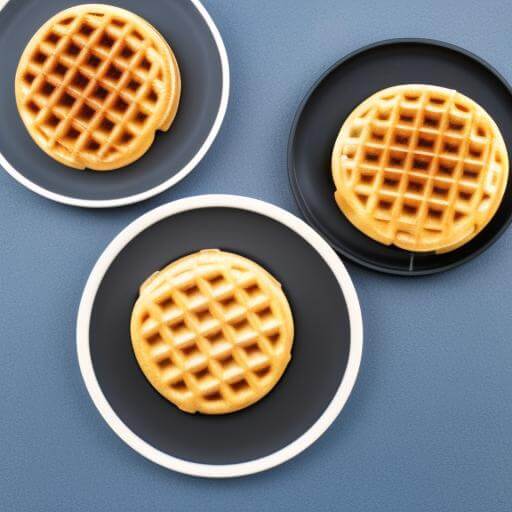If you’re a diabetic, deciding what to eat for breakfast can be a difficult task. Many breakfast foods are high in carbohydrates and sugar, which can cause spikes in blood sugar levels.
One common breakfast favorite is waffles, but the question remains: can diabetics eat waffles? The answer is yes – with some modifications. For example, using whole wheat flour instead of refined white flour can lower the glycemic index.
I will discuss tips for making diabetic-friendly waffles using alternative flours and sweeteners, managing blood sugar levels with waffles, and healthy waffle alternatives for diabetics. So grab your syrup substitute and We will now examine everything about diabetes-friendly waffles!
Table of Contents
Best Waffles for Diabetics
| Product Names | Features |
|---|---|
 Lakanto Pancake and Waffle Mix - Sweetened with Monk Fruit Sweetener and Erythritol | • No added sugar • Nutritional Information per serving: 120 calories, 3 grams of protein, 22 grams of carbs, 17 gram of fiber, 1 gram of sugar • Ingredients: Almond Flour, Tapioca Fiber, Oat Fiber, Vegetable Fibers (Potato, Rice, Plantago), Flour Blend (Pea, Buckwheat), Monkfruit Sweetener (Erythritol, Monk Fruit Extract), Less than 2% Sea Salt, Baking Powder, Natural Flavors, Leavening (Baking Soda), Enzymatic Preparations [Dough Conditioner], Xanthan Gum, Emulsifier (Hypromellose) • Sugar-Free and Sweetened with Monk Fruit: Lakanto sweetens its pancake mix with Monk Fruit Sweetener and Erythritol, natural sugar substitutes. This means you can enjoy delicious, sweet pancakes without the added sugar, making it a healthier choice for those looking to reduce sugar intake. • Reformulated and Now Tastes Better: we removed the Pea Protein from our old Pancake and Baking Mix, removed and added a few other ingredients to enhance the flavor and texture. This mix is specifically crafted for pancakes and waffles. • Gluten-Free: Lakanto Pancake and Waffle Mix is gluten free, making it suitable for individuals with gluten sensitivities or those following a gluten free diet. It allows more people to enjoy pancakes and waffles without compromising on taste or texture. • Easy Preparation: It only requires four additional ingredients: egg, water, oil, vanilla extract. The mix results in pancakes and or waffles with a fluffy texture and excellent mouthfeel, ensuring a delightful breakfast experience. |
 TruEats Pancake & Waffle Mix | • Ingredients: TruEats Flour Blend (Chickpea, Buckwheat, Almond, Moong Dal and Urad Dal Flours), Baking Soda, Erythritol, Cream of Tartar, Xanthan Gum, Sea Salt, Sunflower Lecithin, Monk Fruit Extract, Natural Flavors • PROTEIN & FIBER RICH: TruEats Pancake & Waffle Mix is crafted from carefully selected ingredients that are rich in both protein and fiber to provide energy that lasts all morning long. • LOW GLYCEMIC & GLUTEN-FREE: Sweetened with our all-natural sugar replacer and high quality, gluten-free flours, TruEats Pancake & Waffle Mix bakes up thick & fluffy, making them the perfect start to any morning. • NOTHING ARTIFICIAL: We carefully select high quality, natural ingredients such as chickpeas, dals, buckwheat, and almonds. These ancient grains provide an incredible, natural source of protein, fiber, antioxidants, vitamins and minerals. • LIFESTYLE FRIENDLY: Perfect for diabetic, vegan, dairy free, gluten free, sugar free, GMO free, and plant based diets. • Makes 16-20 Pancakes (4-5” diameter) or 8-9 Waffles (8” diameter) per package. |
 Wonderslim Protein Chocolate Chip Pancake & Waffle Mix | • Nutritional Information: 15 grams of protein, 9 grams of carbs, 1 gram of fiber, 3 grams of sugar • Delicious Pancake & Waffle Mix: Not only is our protein & waffle mix a tasty treat for the taste buds but also a smart choice for those seeking a protein boost in their daily routine at only 90-110 calories & 2.5g or less of fat per serving. • Protein Packed: Start the day right with this healthy twist on a breakfast classic, packed with 15g of protein to feel full and satisfied between meals. • Low Sugar Indulgence: Savor the sweetness guilt-free with our protein pancake & waffles, offering a delectable taste with just 3g or less of sugar per serving. • Breakfast Made Easy: Simply add 2oz water to one packet of mix to create light and fluffy pancakes or waffles. Enjoy with fruit, sugar-free syrup, or on their own. • Trusted Brand: WonderSlim product is made in the USA and 100% employee taste tested & approved. |
 Maple Grove Farms Sugar Free Pancake & Waffle Mix | • Ingredients: Wheat Gluten, Cornstarch, Whole Wheat Flour, Milk Protein Concentrate, Leavening (Sodium Bicarbonate, Monocalcium Phosphate), Salt, Natural Flavor • Nutritional Information: 4 grams of protein, 9 grams of carbs, 1 gram of fiber, 0 grams of sugar • You already love Maple Grove Farms syrup, so why not drizzle it over scrumptious homemade pancakes or waffles • Sugar Free Pancake and Waffle Mix is a low fat, delicious mix made for people needing or choosing to limit sugar intake • The perfect addition to a classic country breakfast • Sealed inner bag to keep the freshness • Now everyone can enjoy the great taste of Maple Grove Farms |
 Vans Power Grains Waffles (pack of 6) | • No high fructose corn syrup • No artificial flavors, colors, or preservatives • Nutritional Information for 2 waffles: 200 calories, 10 grams of plant-based protein, 11 grams of whole grains, 26 grams of carbs, 1 gram of fiber, 6 grams of sugar • Ingredients: Water, Enriched Flour (Unbleached Wheat Flour, Malted Barley Flour, Niacin, Iron, Thiamin Mononitrate, Riboflavin, Folic Acid), Van's Power Grains Mix (Whole Wheat Flour, Cracked Red Wheat, Steel Cut Oats, Millet And Brown Rice), Wheat Protein Isolate, Non-GMO Expeller Pressed Canola Oil, Cane Sugar, Baking Powder (Sodium Acid Pyrophosphate, Baking Soda, Rice Flour, Monocalcium Phosphate), Vital Wheat Gluten, Natural Flavors, Cinnamon, Oat Fiber, Soy Lecithin. • You already love Maple Grove Farms syrup, so why not drizzle it over scrumptious homemade pancakes or waffles • Sugar Free Pancake and Waffle Mix is a low fat, delicious mix made for people needing or choosing to limit sugar intake • Breakfast in just minutes! • Gluten, dairy or egg free • Made with whole wheat flour, steel oats, millet and brown rice |
 Kodiak Cakes Buttermilk & Vanilla Power Waffles (pack of 10) | • All Non-GMO Ingredients • Made with 100% whole grains and 14 grams of protein per serving (2 waffles) • Nutritional Information for 2 waffles: 260 calories, 12 grams of protein, 29 grams of carbs, 4 gram of fiber, 6 grams of sugar • Ingredients: Water, 100% Whole Grain Wheat Flour, Canola Oil, Cane Sugar, 100% Whole Grain Oat Flour, Whey Protein Concentrate, Whey Protein Isolate, Wheat Protein Isolate, Wheat Gluten, Buttermilk, Egg Whites, Sunflower Lecithin, Leavening (Sodium Acid Pyrophosphate, Sodium Bicarbonate) Guar Gum, Sea Salt, Natural Flavor, Vanilla Extract. |
Can Diabetics Eat Waffles?
This section will look at the impact of carbohydrates on blood sugar levels and provide tips for making diabetic-friendly waffles using alternative flours and sweeteners, while also emphasizing the importance of limiting portion sizes and toppings.
Understanding The Impact Of Carbohydrates On Blood Sugar Levels
Carbohydrates, a macronutrient found in foods such as bread, pasta, and waffles, can have a significant impact on blood sugar levels for diabetics. When digested, carbohydrates are broken down into glucose and released into the bloodstream. As a result, consuming too many carbs at once can cause blood sugar levels to spike quickly.
For diabetics, it is essential to manage their carbohydrate intake to keep their blood sugar levels stable throughout the day. This involves choosing carbohydrate sources with a lower glycemic index (GI), which means they do not raise blood sugar levels as much as high GI foods like white bread or sugary cereal. It also involves limiting portion sizes and combining carbs with protein and healthy fats to slow digestion and prevent rapid spikes in blood sugar.
Tips For Making Diabetic-friendly Waffles Using Alternative Flours And Sweeteners

Another key tip is to experiment with recipes that use other non-traditional ingredients such as coconut oil or apple sauce in lieu of butter. This can help reduce the fat content while still adding flavor and texture. Pairing your waffles with protein-rich toppings like Greek yogurt and fresh berries is also recommended for better digestion and sustained energy throughout the day.
Limiting Portion Sizes And Toppings
When it comes to eating waffles with diabetes, portion control is important. A typical serving size of waffles is one or two, depending on the recipe and size. It’s also important to choose healthy toppings that won’t spike blood sugar levels. Instead of sugary syrups, try topping your waffles with fresh berries and a dollop of plain Greek yogurt for added protein.
Another way to limit portion sizes is by making smaller, mini waffles instead of full-sized ones. This can help you keep track of how many carbs you’re consuming while still enjoying a tasty breakfast. Using low-carb flours like almond flour or coconut flour in the batter can also make diabetic-friendly waffles that are lower in carbohydrates and more suitable for managing blood sugar levels.
Managing Blood Sugar Levels With Waffles
Pair waffles with protein and healthy fats to slow digestion, incorporate exercise into meal plans, and monitor blood sugar levels to effectively manage blood sugar levels when consuming waffles as a breakfast option for diabetics.
Pairing Waffles With Protein And Healthy Fats To Slow Digestion
It’s important for diabetics to pair their waffles with protein and healthy fats to help slow down digestion. This can help prevent sudden spikes in blood sugar levels. Adding some nuts or nut butter, Greek yogurt, or a side of eggs are all great options for adding protein and healthy fats to your diabetic-friendly waffles.
Also incorporating exercise into your meal plan can also help manage blood sugar levels when eating waffles. Going for a walk after breakfast or doing some light stretching can promote better glucose uptake by the muscles. Always make sure to monitor your blood sugar levels as well so that you can adjust your meals and exercise accordingly to maintain a consistent level throughout the day.
Incorporating Exercise Into Meal Plans
Incorporating exercise into a diabetic-friendly meal plan is crucial for managing blood sugar levels. Even light physical activity like taking a brisk walk after breakfast can help keep glucose in check. Pairing waffles with protein and healthy fats, such as scrambled eggs or Greek yogurt, before exercising can slow down digestion and prevent post-meal spikes in blood sugar.
Also strength training exercises that build muscle mass may also improve insulin sensitivity and lower blood sugar levels. It’s important to start slowly and consult with a healthcare provider before starting any new exercise routine. Monitoring blood sugar levels during and after exercise is also recommended to ensure safe workouts that don’t cause hypoglycemia or hyperglycemia.
The Importance Of Monitoring Blood Sugar Levels
It’s crucial for diabetics to monitor their blood sugar levels regularly, especially after consuming meals that contain carbohydrates. Waffles are a high-carbohydrate food, which can cause a spike in blood sugar levels if not consumed in moderation. By monitoring glucose levels, diabetics can adjust their meal plans accordingly and ensure they maintain healthy blood sugar levels.
Regular exercise is also essential in managing diabetes and preventing complications related to the disease. Incorporating physical activity into your daily routine can help improve insulin sensitivity, which aids in regulating blood sugar levels. Along with monitoring glucose levels and exercising regularly, following a balanced diet is important to managing diabetes effectively. This includes opting for low-carb waffle alternatives or pairing waffles with protein-rich foods such as eggs or turkey bacon to slow down digestion and prevent rapid spikes in blood sugar levels.
Healthy Waffle Alternatives For Diabetics
Some healthy waffle alternatives for diabetics include whole-grain waffles, gluten-free waffles, and low-carb waffles made with almond flour or other alternative flours.
Whole-grain Waffles
Whole-grain waffles are a great option for diabetics who want to enjoy this breakfast staple without the guilt. Made with flour that includes the entire grain kernel, they are a rich source of fiber and other essential nutrients. Whole grains have a low glycemic index and can help regulate blood sugar levels, making them an excellent choice for those managing diabetes.
To make whole-grain waffles even healthier, try using whole wheat or oat flour instead of refined white flour. These flours have more complex carbohydrates and take longer to digest, leading to a slower release of glucose into the bloodstream. To sweeten your waffles naturally, opt for maple syrup or fresh fruit toppings instead of sugary syrups or whipped cream.
Gluten-free Waffles
Gluten-free waffles are a great option for diabetics who need to watch their carb and gluten intake. Gluten is a protein found in wheat, barley, and rye that can cause inflammation in some people. By using alternative flours like rice flour or almond flour, one can make gluten-free waffles that are both tasty and healthy.
Compared to regular waffles, gluten-free waffles tend to have fewer carbs and calories per serving. This makes them an ideal choice for those with diabetes who need to limit their sugar intake but still want a delicious breakfast option. Also many people without gluten intolerance prefer the taste of gluten-free waffles as they tend to be lighter and crispier than traditional ones.
Low-carb Waffles
Low-carb waffles are a great option for diabetics who want to enjoy their breakfast without worrying about blood sugar spikes. These waffles are made with alternative flours like almond or coconut flour and low-carb sweeteners like stevia or erythritol. With fewer carbs than traditional waffles, they help control blood sugar levels while providing the same delicious taste.
One of the benefits of low-carb waffles is that they can also be high in protein, which helps slow down digestion and prevent sudden spikes in blood sugar levels. Adding toppings like berries, nuts, and Greek yogurt can further boost the nutritional value of these breakfast treats.
Recommendations For Making Waffles A Healthier Option For Diabetics
When it comes to making waffles healthier for diabetics, there are several tips to keep in mind. For starters, try using alternative flours such as almond or coconut flour instead of traditional wheat flour. These flours are lower in carbohydrates and won’t spike blood sugar levels as much. Also experiment with natural sweeteners like stevia or monk fruit extract instead of traditional sugar.
Another important recommendation is to watch portion sizes and toppings. While a stack of Belgian waffles with syrup and butter might be tempting, it can have over 600 calories and a high glycemic index that can cause blood sugar spikes. Instead, try limiting the serving size or topping your waffle with fresh berries, nut butter, or Greek yogurt for added protein.
FAQs:
1. Are waffles safe for diabetics to eat?
Waffles can be enjoyed by diabetics, but it’s important to watch portion sizes and choose the right ingredients. Opting for whole grain or low-carb flours, sugar-free syrups and toppings, and limiting added sugars can help keep blood glucose levels under control.
2. How can I make my waffles healthy for a diabetic person?
Some tips for making healthier waffles include using whole grain flour or almond flour instead of white flour, adding in high-fiber ingredients like flaxseed meal or chia seeds, and sweetening with natural sugar substitutes like stevia or monk fruit.
3. Can diabetic people eat frozen store-bought waffles?
Diabetic people can eat frozen store-bought waffles as long as they check the nutrition information on the package carefully. Look at the total carbohydrate count per serving and try to choose options with lower carb counts, especially if pairing with other high-carb toppings like syrup.
4. Is it okay for diabetics to have regular syrup on their waffles?
Regular syrup is typically high in sugar and carbs which could lead to spikes in blood glucose levels in diabetics. It’s better to opt for a sugar-free syrup made from artificial sweeteners such as erythritol or xylitol that won’t cause abrupt fluctuations in insulin production leading towards diabetes complications over time.


